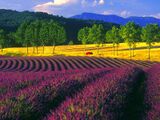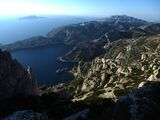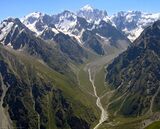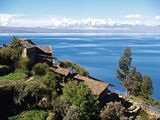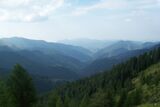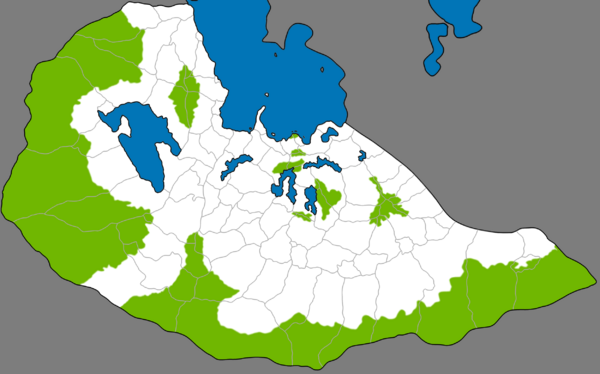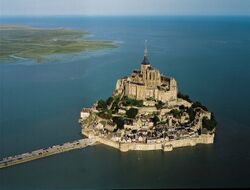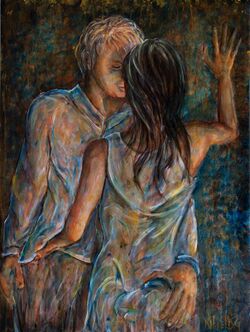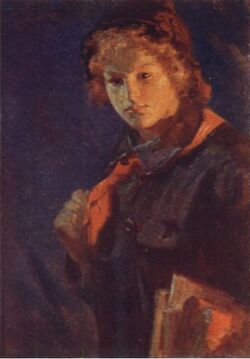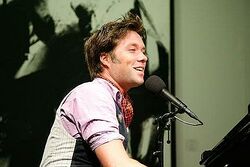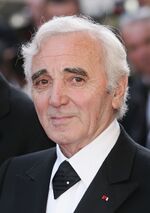Varkana
| Varkana საქართველო Sakartvelo |
||||||
|---|---|---|---|---|---|---|
|
||||||
| Motto: სიბრძნე, სამართლიანობა, სიმამაცე, თავშეკავებისკენ "Wisdom, Justice, Fortitude, Restraint" |
||||||
| Anthem: "თავისუფლება" "Freedom" |
||||||
Location of Varkana in Adonia
|
||||||
| Capital and largest city | Klow | |||||
| Official languages | Kartvelian | |||||
| Recognised regional languages | Aetolian Galian Kaspian Vlahestian |
|||||
| Demonym | Varkan | |||||
| Government | Aristocratic communalist constitutional semi-presidential unitary republic |
|||||
| - | President | Giorgi Latso | ||||
| - | Council of Ten | Members | ||||
| Legislature | Parliament | |||||
| Constitutional history | ||||||
| - | Independence from Aetolia | 1758 | ||||
| - | First Republic | 1760 | ||||
| - | Second Republic | 1882 | ||||
| - | Third Republic | 1943 | ||||
| - | Fourth Republic | 2004 | ||||
| Area | ||||||
| - | Total | 166,736 km2TEMP STAT 64,377 sq mi |
||||
| - | Water (%) | 4.6% | ||||
| Population | ||||||
| - | 2014 estimate | 28,412,230 | ||||
| - | 2012 census | 28,159,672 | ||||
| - | Density | 168.9/km2 437.4/sq mi |
||||
| GDP (PPP) | 2014 estimate | |||||
| - | Total | 798,156,365,160ლ | ||||
| - | Per capita | 28,092ლ | ||||
| Gini (2014) | 16.8 low · 1st |
|||||
| HDI (2014) | .894 very high · ??th |
|||||
| QLI (2014) | 8.051 very high | |||||
| IEF (2014) | 52.5 Mostly Free | |||||
| Currency | Lari (ლ) (VAL) |
|||||
| Time zone | ACT+2 (UTC+2) | |||||
| Date format | dd.mm.yyyy CE | |||||
| Drives on the | right | |||||
| Calling code | +44 | |||||
| Internet TLD | .va, .ვა | |||||
Varkana ("German": /vɑʀkanɑ/) (Kartvelian: საქართველო, Sakartvelo) is an aristocratic communalist constitutional semi-presidential unitary republic in northwestern Illypnia. Varkana borders Aetolia in the northeast, country in the east, country, country and country in the south, country in the west, country and country to the northwest and the Mesogean Sea in the north.
By area, Varkana is the ??th largest country in Adonia. With a population of approximately ?? million, it is the ??th most populated country in Adonia and the ??th most populated country in Illypnia. Varkana has its capital in the commune of Klow, the nation's largest city and the main cultural and commercial center. The current Constitution of Varkana, adopted by referendum in December 2004, establishes the country as aristocratic communalist and democratic, with its sovereignty derived from the people. The nation's ideals are expressed in its motto: "Wisdom, Justice, Fortitude, Restraint".
During the classical era, independent kingdoms became established in what is now Varkana. The kingdoms of Klow and Valyria consolidated the Kartvelian peoples and languages through a unified Kingdom of Varkana in the early 4th century. The Kingdom reached the peak of its political and economic strength in the 11th–12th centuries. After this the area was dominated by various large Empires, including the Persians and the Aetolians. In 1758, Varkana started a war for independence from Aetolia, the Varkan Restoration War, and formed the First Republic of Varkana in 1760. After a coup d'état in 1882, communists and socialists led by Ana Kalanda, formed the Socialist Republic of Varkana. After the Great Adonian War, the Third Republic of Varkana was established under a capitalistic social democratic welfare state. This lasted until the Varkan revolution of 2004, after which the new government introduced aristocratic communalism and thus founded the Fourth Republic of Varkana.
Varkana is strategically located in the middle of Western Illypnia and remains a local power with significant cultural, economic, and political influence in Illypnia and around Adonia. Varkan citizens enjoy a high standard of living, and the country performs well in international rankings of education, health care, life expectancy, civil liberties, and human development. Varkana is a founding member of the Adonian Community and is also a member of numerous other international institutions, including the Adonian Council of Energy and Energy Standard Organization.
Etymology
The full, official name of the country is "Varkana", as specified in the Varkan constitution. "Varkana" is an exonym, used in other countries since the medieval period. It is presumably derived from the Middle Persian varkâna, meaning "land of wolves". The self-designation used by ethnic Varkans is Kartvelebi (ქართველები, i.e. "Kartvelians"), the native name of Varkana Sakartvelo (საქართველო) "land of Kartvelians" and of the Karvelian language Kartuli (ქართული).
History
Geography
Varkana is located in the very bottom of the Sea of Aetolia, the southernmost arm of the Mesogean Sea. It is bordered by Aetolia to the northeast, ?? to the east, ?? to the southeast, ?? to the south, ?? to the southwest, ?? to the west, ?? to the northwest, and Armazia to the north.
The Fjords, known as the ფიორდი მთები piordi mtebi in Kartvelian, are a dramatic feature of the Varkan coast, a 20-km long series of narrow inlets in the cliffs of the coastline between Klow on the west and Oni on the east. The highest peak in the mountains is is 565 meters high. The best known fjords of the piordi mtebi include სორმიუ sormiu, მორგიუ morgiu, and სუგიტო sugito.
The phrygana is the typical landscape of northern Varkana: a type of low, soft-leaved scrubland or chaparral found on limestone soils around the Mesogean Sea basin, generally near the coast, where the climate is moderate, but where there are annual summer drought conditions. Juniper and stunted holm oaks are the typical trees; aromatic lime-tolerant shrubs such as lavender, sage, rosemary, wild thyme and Artemisia are common phrygana plants. The open landscape of the phrygana is punctuated by dense thickets of Kermes oak.
The interior of Varkana is a hilly landscape, composed of relatively low mountain ranges, usually below 1,000 meters high, without sharp peaks, rising to 2,000 meters in the central mountains. There are many rivers, most running down relatively gentle slopes in large river valleys, though at times their courses become far more rugged and narrow.
The ??? Mountains (west) form the country's western boundary and the ??? Mountains (south) form most of its southern boundary, where Varkana's highest point is located on ??? (altitude in meters). Lake Paravani is the largest lake of the country, located on a plateau in the western communes. Mount Holy-Victory is probably the best-known mountain in Varkana, thanks to the painter Lado Gudiashvili, who could see it from his home, and painted it frequently. It is a limestone mountain ridge which extends over 18 kilometers to the west of Zestafoni. Its highest point stands at 1,011 meters.
Climate
The climate of Varkana is extremely diverse, considering the nation's size and location. There are two main climatic zones, roughly separating northern and southern parts of the country. The country's various mountain ranges play an important role in moderating Varkana's climate and protect the nation from the penetration of colder air masses from the south or hot air masses from the west. The mountainous central lands also protect the inland from the hot and dry air masses from the north.
Much of northern Varkana lies within the southern periphery of the Mesogean climate zone with contrasting temperatures within a range of 15 degrees. Precipitation is irregular, with only 65 days per year where rain falls in excess of 1 mm. However, it falls in sudden downpours, with an average of 500–700 mm annually. This mainly happens in the spring and fall ; summer is very hot, winter mild. Violent winds are common, especially the famed mistral, which blows 100 days per year with a maximum of 100 km/hr. The coast is drier, especially near Klow, the Fjords and the Bay of Oni, which include the driest areas in Varkana, with only 450 mm of rain per year.
The climate of the south varies significantly with elevation and while much of the lowland areas of southern and central Varkana are relatively warm throughout the year, the foothills and mountainous areas experience cool, wet summers and snowy winters (snow cover often exceeds 2 meters in many regions).
| Landscapes of Varkana | ||||||||||
Government and politics
Varkana is an aristocratic communalist constitutional semi-presidential unitary republic. The Fourth constitution of Varkana was approved by referendum in December 2004. The executive branch itself has two leaders: the President of Varkana, currently Giorgi Latso, who is head of state and is elected directly by universal adult suffrage for a 4-year term and conducts mainly the foreign policy, and the Government, led by the Council of Ten, representing the Varkan aristocracy.
The Parliament is a unicameral legislature and is composed of 200 members of whom 100 are elected by the population for four years. The 100 other MPs are appointed by the Council of Ten every year, using the party-list system. The government is formed by the Council of Ten who head each Departments and act as a collective premiership and MPs appointed by the Parliament who run each Ministries.
Law
The Law of Varkana is the legislation in force in the Republic of Varkana, which is understood to mean Varkan territory, Varkan waters, consulates and embassies, and ships flying the Varkan flag in international waters and airspace. Varkan law stems from the Kartvelian people through democratically elected institutions. Varkan law is supported principally by the law in the broad sense (laws and regulations) and to a lesser extent by judicial decisions and customs. The supreme Varkan law is the Constitution of 2004, which regulates the functioning of public bodies and the fundamental rights of the Kartvelian people, as well as the organization and competencies of the different communes. The Constitution, as well as being directly applicable by the judiciary, enjoys a material supremacy that determines the rest of the laws in Varkana. All laws in Varkana must be declared compatible with the Constitution (all laws that contravene the Constitution are invalid). However, it is clear that a public body is needed to regulate the fulfillment of this rule. In Varkana's case, a Constitutional Court exists, which follows the Kelsenian model. The judicial powers fall into the hands of the judges and courts, an office which the public has access to, and in a jury, which is formed by nationals chosen by lottery in every case. The Constitutional Court controls the laws and the actions of the public administration must fit into the Varkan Magna Carta.
Marriage is considered a religious institution and is subject to approval by the State to be deemed legal and considered as a civil union. Civil Union is the ultimate and sole legal partnership in Varkana and is guaranteed equal access for same-sex couples. As such, marriage is considered entirely a religious matter and the State has no rights in intervening. But the State reserves itself the right to refuse to recognize and therefore legalize a said marriage if it is not constitutional.
Administrative divisions
A clickable map of Varkana exhibiting its 84 communes and their coat of arms.
|
Varkana is a unitary state divided into 84 communes and 3,400 villages. All of the territory of the Republic of Varkana is covered by communes except in government lands where the communes do not have local representation and is directly administered by the state. This apart, powers, size, population in communes may vary considerably from one to another. Communes are a supralocal type of regional municipality, and act as the local municipality in unorganized territories within their borders. Most communes are subdivided into villages, which act as local municipalities. The council of a commune is composed of the mayors of the member villages (municipalities) as well as a prefect. The prefect is usually elected by and from the council by secret ballot. Universal suffrage may also be used. The prefect's mandate is 2 years when elected by council or 4 years when elected by universal suffrage. The council and prefect act as the executive entity of the commune, while the people/citizens act as the legislature.
The communes have a permanent constitutional status and, in comparison with the situation in other countries, a high degree of independence for an administrative division in a unitary state. Their main areas of responsibility include the management of a number of social and welfare allowances, of compulsory education (primary and secondary) buildings and technical staff, of local roads and school and communal transportation, and infrastructures. Contrary to most countries, a commune in Varkana holds considerable power on its local economic policy.
Villages or districts in urban communes such as Senaki or Klow, on the other hand, form the second-level administrative division of Varkana. Villages typically are based on pre-existing towns and facilitate local governance. All villages have names, but not all named geographic areas or groups of people residing together are villages, the difference residing in the lack of administrative powers. The villages are the lowest level of administrative division in Varkana and are governed by elected officials, the mayor, with extensive autonomous powers to implement communal policy. The mayor of a village is also a member of the communal council and therefore is responsible to represent their village to the rest of the commune.
Varkan law makes allowances for the vast differences in commune size in a number of areas of administrative law. The size of the communal council, the method of electing the prefect and mayors, and the maximum allowable pay of the prefect and mayors (among other features) all depend on the population echelon into which a particular commune falls.
Foreign Relations
The foreign policy of Varkana is based on its identity as a sovereign nation in Illypnia. As such its primary foreign policy focus is on its relations with other nations as a sovereign independent nation. The Varkan government's officially stated goal is to establish a new world order based on its motto: "Wisdom, Justice, Fortitude, Restraint". However, the current President of Varkana, Giorgi Latso, stated that these terms should be understood in the context of a global aristocratic communalist socioeconomic system. Varkana's foreign relations are based on two strategic principles: eliminating outside influences in the region and pursuing extensive diplomatic contacts with allies and potential allied countries. Varkana is said to have a "vital relationship" with Aetolia and a close partnership with TBD, the "NAME PENDING".
During the Third Republic era, Varkana combined its policy of non-alignment and a low profile in international affairs with a security policy based on strong national defence. The function of the Varkan military was to deter attack. At the same time, the country maintained relatively close informal connections with various nations, especially in the realm of intelligence exchange.
Following the Varkan revolution, in 2004, Varkana attempted to play a more significant and independent role in international relations with the election of Zurab Avalishvili as President. It involved itself significantly in international peace efforts, especially through the Adonian Community. Since the election of Giorgi Latso as President in 2012, Varkana has adopted a more moralistic and unconventional foreign policy approach. Nevertheless, the country remains active in peace keeping missions.
Military
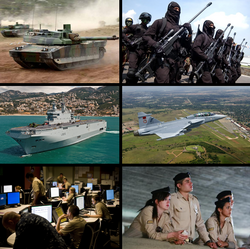
The Military of Varkana is divided into 7 branches: the National Guard, the Land, Sea, Air, Cyber and Special forces, and the Coast Guard. The President of Varkana holds the title of commander-in-chief of the nation's armed forces and appoints its leaders, the Secretary of Defense. The Presidency administers the armed forces. The Coast Guard is run by the Department of the Interior in peacetime and by the Presidency during times of war. In 2014, the armed forces had ??? personnel on active duty. The reserves and National Guard brought the total number of troops to ???. The presidency also employed about ??? civilians for the military.
Military service is voluntary, and conscription may never occur, even in wartime as specified by law. Varkan forces can be rapidly deployed in Illypnia and Kaftia. The military operates two bases and facilities abroad, the ??? Military Base and ??? Military Base. The military budget of Varkana in 2014 was ???ლ, at around 1.5% of GDP.
As far as the Varkan intelligence units are concerned, the SSD (სსდ) is considered to be a component of the military under the authority of the Secretariat of Defense. Varkana has signed but not ratified the Chemical Weapons Convention (CWC) and maintains an important stockpile of chemical weapons. It has signed and ratified the Comprehensive Nuclear-Test-Ban Treaty (CTBT) and acceded to the Nuclear Non-Proliferation Treaty.
Economy
Transports
Demographics
With an estimated population of 28 million people as of 2012, Varkana is the ??th-most populous country in Adonia and the ??th-most populous in Illypnia. Most historians and scholars of Varkana as well as anthropologists, archaeologists and linguists tend to agree that the ancestors of modern Kartvelians inhabited the region since the Neolithic period. Scholars usually refer to them as Proto-Kartvelian tribes. Some Illypnian historians of the 19th century (e.g., Wilhelm von Humboldt and Paul Kretschmer) as well as Varkan scholars (R. Gordeziani, S. Kaukhchishvili and Z. Gamsakhurdia) came to the conclusion that Proto-Kartvelians might be related linguistically and culturally to the indigenous (pre-Indo-European) peoples of ancient Illypnia including the "Pelasgians", "Etruscans" and Proto-"Basques". A law originating from the First Republic and reaffirmed in the 2004 Constitution makes it illegal for the Varkan state to collect data on ethnicity and ancestry. Varkana is a highly urbanized country, with its largest communes in 2012 being Klow.
Largest metropolitan areas of Varkana
Government of Varkana | |||||||||
|---|---|---|---|---|---|---|---|---|---|
| Rank | Communes of Varkana | Pop. | Rank | Communes of Varkana | Pop. | ||||
 Senaki  Klow |
1 | Senaki | Senaki | 2,188,759 | 11 | Zestafoni | Zestafoni | 424,682 |  Kaspi  Borjomi |
| 2 | Klow | Klow | 1,820,941 | 12 | Zaglianu | Zaglianu | 403,153 | ||
| 3 | Kaspi | Kaspi | 1,522,123 | 13 | Terjola | Terjola | 372,992 | ||
| 4 | Borjomi | Borjomi | 1,250,251 | 14 | Chiatura | Chiatura | 351,023 | ||
| 5 | Tsqaltubo | Tsqaltubo | 675,122 | 15 | Mestia | Mestia | 210,592 | ||
| 6 | Telavi | Telavi | 606,987 | 16 | Kojori | Kojori | 178,592 | ||
| 7 | Abasha | Abasha | 535,123 | 17 | Anaklia | Anaklia | 155,601 | ||
| 8 | Sioni | Sioni | 505,692 | 18 | Valko | Valko | 144,226 | ||
| 9 | Pitsunda | Pitsunda | 476,129 | 19 | Agara | Agara | 131,892 | ||
| 10 | Gali | Gali | 438,920 | 20 | Kapo | Kapo | 128,954 | ||
Languages
The official language of Varkana is Kartvelian. The Kartvelian language is neither Indo-European, Turkic nor Semitic. It is written in its own unique writing system, the Kartvelian script. According to the 2012 population census, 90.767% of the population declared Kartvelian as their mother tongue ("mother tongue is defined as the first or main language spoken at home during childhood"). 2.8% of the population declared Aetolian as their mother tongue, while 2.4% declared it was Kaspian, 1.5% Galian and 0.3% Vlahestian. The latter four languages are recognized as regional languages by the national government, being official in several communes in the country.
Kartvelian has a rich word-derivation system. By using a root, and adding some definite prefixes and suffixes, one can derive many nouns and adjectives from the root. For example, from the root -kartv-, the following words can be derived: Kartveli (a Varkan/Kartvelian person), Kartuli (the Kartvelian language) and Sakartvelo (Varkana).
Most Varkan surnames end in -dze, -shvili, -ia, -ani, -uri, etc. The ending -eli is a particle of nobility, equivalent to "German" von or "Polish" -ski.
Kartvelian has a vigesimal number system, based on the counting system of 20, like "Basque". In order to express a number greater than 20 and less than 100, first the number of 20s in the number is stated and the remaining number is added. For example, 93 is expressed as ოთხმოცდაცამეტი - otkh-m-ots-da-tsameti (lit. four-times-twenty-and-thirteen).
Religion
Armazism is the national religion of Varkana, considered as sectarian by most countries in Adonia. The collective influence of Armazism on the country's political, economic and cultural life is significant. The Varkan Constitution guarantees freedom of religion, but the government only recognizes Armazism as an official religion. Varkana recognizes agnosticism and atheism, while any other religion is considered as a sect. Varkana is a secular country in which the state must respect all religions or sects. Any such sects are legal and they are only reprehensible if they violate the law. In the 2012 Varkan census, 87.18% of Varkans identified themselves as Armazists, 6.96% Agnostics, 2.91% Atheists, 1.69% Buddhist, and 1.28% unstated.
The Varkan ???? Law On Sects, in its own words, aims at movements deemed cultic that "undermine human rights and fundamental freedoms". The law does not define new crimes, except in association with existing crimes. The law is causing controversy internationally, with some commentators alleging that it infringes religious freedom. Proponents of the law allege, on the contrary, that it reinforces religious freedom, since it aims at protecting people in a weak position (including children), preventing criminal organizations from forcing such people into religious and other activities. For instance, minors may not join any religious organizations including Armazism until reaching the age of majority, 16 year old. Private religious practice (for children) is however not restricted if done in family (activities such as praying or reading 'holy' books).
With little tolerance on other religions than Armazism practiced in Varkana, conflicts with followers of different religions arise periodically. Moreover, Varkana's political leadership has played an important role in the relations between groups, both positively and negatively, promoting mutual respect by affirming the Constitution but also promoting the state religion, which has caused a number of conflicts in certain regions of the country.
The advocacy group Freedom House produced a report entitled "Religious Freedom in the World" in 2012 which ranked countries according to their religious freedom. Varkana received a score of 7, indicating it was one of the countries where religious freedom was least respected. The President of Varkana, Giorgi Latso, dismissed such scores, stating that it is "biased on a pre-established false premise that no religion is better than another which is obviously false and a wet dream of egalitarian utopian delusional people".
Health
Varkana has a universal health care system that is administered by the Department of Health and paid for mostly by taxes (85%) and to a lesser extent by service fees (15%). Unlike most developed nations, there are no private hospitals, and private insurance is nonexistent. Every Varkan citizen can freely obtain public health insurance, provided by the government.
A considerable portion of the government budget is assigned to health care, and Varkana ranks ??th in health care expenditures as a percentage of GDP and ??th in spending per capita in Adonia. Overall, the country's health care system is one of the best performing on the planet, ranked ??th by the Adonian Health Organization. As of 2012, Varkana had 3.8 doctors per 1,000 people and 15.3 nurses per 1,000 people. Varkans are among the world's healthiest people, with 81% reporting to be in good health, according to an independent survey. The average life expectancy is 78 years old.
However, the health of the inhabitants of Varkana is not optimal in all areas. Despite the drop in wine consumption since the 1960s, Varkans remain the third largest drinkers in Illypnia. 40% of 18-75 years smoked daily (marijuana or tobacco) in 2010, despite intense campaigns against smoking. Smoking in public places including pubs, restaurants, night clubs and offices has been banned. Restaurants with certain permits are allowed for smokers, most notably for shisha cafés.
Education
The education system in Varkana considerably changed from a system modeled on the interests of industrialization to the interests of progress and self achievement. Nowadays, the schooling system in Varkana is completely centralized, and is composed of two stages, general education and higher education.
Compulsory education, or general education, comprises primary and secondary education, which is most of the time conducted at the same institution. Education is mandatory by law for children aged from 6 to 18 years. The school year lasts eight months, beginning between 21 August and 1 September, ending between 31 May and 10 June with two months of holidays during the winter and two months during the summer. Courses take place five days a week. All schools in Varkana are mixed sex schools.
Primary education consists in a curriculum of basic courses for the development of a primary set of knowledge as guided by the government. These courses include intensive Kartvelian classes, mathematics, history and physical education, among others. Students are to pass all these classes before being able to begin secondary education. They therefore fulfill their primary education at similar levels and ages. Usually, students finish their primary education at the age of 12.
Secondary education is different than primary education. Students get a lot more liberties than in primary school. They are to decide which classes they want with a series of class points. Certain classes give more points than others and follow levels. For instance, a student who hasn't pass Geography 1 couldn't register for Geography 2. Students are required to all have general courses or formation, which include Kartvelian language classes, physical education, philosophy and a foreign language class of which Aetolian is the most common choice. "German" is also relatively popular. This education system shows uncommon characteristics such as students of different age studying in the same class.
Higher education in Varkana compromises ten universities. These universities are entirely publicly funded by the Department of Education. They are actively part of the political system of Varkana by which teachers elect the university's rector who chooses a student of their university to become a Ten's Councillor based on a series of criteria.
Culture
Architecture
Varkana has a very broad and diverse architectural style, which cannot be simply classified by period, but also by commune, because of Varkana's division into several communes since the 19th century. This has created a highly diverse and eclectic range in architectural designs. Varkan architecture is influenced by a number of architectural styles, including several each for castles, towers, fortifications and temples. The communes in the north of the country have more traditional Mesogean style of architecture, heavily influenced by Aetolian classical architecture and neighbouring nations.
Varkan architecture includes a rich collection of monuments from the Aetolian antiquity era; Armazist temples from the Romanesque period, medieval palaces and temples; fortifications from the time of early Republic, as well as numerous hilltop villages and fine temples. Varkana was a relatively poor region after the 18th century, but in the 20th century it had an economic revival and became the site of one of the most influential buildings of the 20th century, the Housing Unit of the architect Le Corbusier in Klow.
As Aetolian authority crumbled in Varkana in the Antiquity, the region was flooded with invaders from all sides. Varkana nevertheless prevailed as a Kingdom until annexation by Aetolia in YEAR. Because of the repeated invasions, Varkan architecture was designed to resist attack. Temples were surrounded by towers and walls, and even the bishop's residence in Bolnisi resembled a fortress. Castles on hilltops surrounded by walled towns became the characteristic architectural feature of Varkana. Only in the 18th century, after the First Republic had established its authority, were the towns of Varkana safe from outside attack.
Art
Varkana has a rich heritage in the visual arts, especially in frescoes, murals and icons. Visual arts in the Varkan lands experienced an upsurge during the entire period of the Middle ages, pushed by the establishment of Armazism as national religion.
The Citadel features an exhibition of a large collection of medieval icons. The earliest of those dates from around the 9th century AD. The Klow Artistic School, the mainstream of the Varkan fine arts and architecture between 13th and 14th centuries, takes its name from the capital of Varkana. Although it shows the influence of some tendencies of the Palaeologan Renaissance while Varkana was an integral part of Aetolia, the Klow painting had its own unique features which makes it a separate artistic school. Art historians classify its products into two types:
- mural painting: mural decoration of churches
- iconography: easel painting
The works of the school show some degree of realism, portrait individualism and psychology. The unique and realistic portraits in The Citadel class as forerunners of the Renaissance.
The wall piers and the arches often featured medallion-shaped bust images of deities. Magnificent examples of those survive in the Dedamitsaze Temple in Klow. Along with traditional scenes such as "The Five Children" in the second layer; "The Twins" in the dome and "Dedamitsaze & Tetri Giorgi" in the apse, specific images and scenes also appear. In the late 19th century and early 20th, a new form of art evolved in Varkana: socialist realism. The impressionist movement became known to be anti-Second Republic and a form of modernism, and was relatively oppressed by the authorities. After the foundation of the Third Republic, the Varkan art scene immediately went roughly in several directions. There were those who continued in the artistic experiments of the 1930s and 1940s, especially Surrealism and Geometric abstraction, and there were those associated with Lyrical abstraction, Tachisme, Nuagisme, Art Informel and Abstract Expressionism.
Around the late 1960s, graffiti was used as a form of expression by political activists who mainly opposed the Third Republic or other countries, and also by gangs in Klow to mark territory. Graffiti is one of the four main modern elements of Varkan visual culture. The relationship between graffiti and the authorities was clashing, as graffiti usually opposed the establishment. After the Varkan revolution, graffiti were now praised by various people, to the point where building owners would request artists to make graffiti at ease on their building.
Music
The Varkan myth of national creation goes something like this: when Dedamitsaze was distributing land among its children, humans, the Varkans were too busy drinking and feasting to turn up on time. When they finally arrived there was nothing left. 'But Goddess', they protested, 'we were only late because we were toasting you!' Touched by this sentiment, Dedamitsaze gave them the land she had been keeping for herself...
Ever since, feasting has been central to Varkan society and still provides the principal occasion for making music. People gather for a lavish picnic at the slightest excuse, led by a tamada or 'toastmaster' in dedicating toasts to the gods, long life and the ancestors, among other things. Each toast is accompanied by an appropriate song, as well as snippets of wisdom from the tamada.

Varkana has rich and still vibrant traditional music, which is primarily known as arguably the earliest polyphonic tradition of the Western world. Situated on the border of Western Illypnia and Eastern Illypnia, Varkana is also the home of a variety of urban singing styles with a mixture of native polyphony, Western Fosian monophony and late Western Illypnia harmonic languages. Varkan performers are well represented in the world's leading opera troupes and concert stages.
The folk music of Varkana consists of at least fifteen regional styles, known in Varkan musicology and ethnomusicology as "musical dialects". Varkan folk music is predominantly vocal and is widely known for its rich traditions of vocal polyphony. It is widely accepted in contemporary musicology that polyphony in Varkan music dates back to the Antiquity. All regional styles of Varkan music have traditions of vocal a cappella polyphony. Vocal polyphony based on ostinato formulas and rhythmic drone are widely distributed in all Varkan musical styles. Apart from these common techniques, there are also other, more complex forms of polyphony: pedal drone polyphony and contrapuntal polyphony. Contrapuntal polyphony features the local variety of the yodel, known as krimanchuli.
Singing is mostly a community activity in Varkana, and during big celebrations (for example, weddings) all the community is expected to participate in singing. Traditionally, top melodic parts are performed by individual singers, but the bass can have dozens or even hundreds of singers. There are also songs (usually more complex) that require a very small number of performers. Out of them the tradition of "trio" (three singers only) is very popular in coastal communes. Varkan folk songs are often centered around banquet-like feasts called supra, where songs and toasts to the gods, peace, motherland, long life, love, friendship and other topics are proposed. Traditional feast songs include "Zamtari" ("Winter"), which is about the transient nature of life and is sung to commemorate ancestors, and a great number of "Mravalzhamier" songs. As many traditional activities greatly changed their nature (for example, working processes), the traditional feast became the harbor for many different genres of music. Work songs are widespread in all communes.
Varkan Classical is one of the most performed in Adonia; Varkan composers include some of the most accomplished and popular in history, among them Dimitri Shostakhvari, Zakaria Paliashvili, Andria Balanchivadze, Viktor Dolidze, Otar Taktakishvili and Giya Kancheli. The allegro molto of Shostakhvari's String Quartet No. 8 is known to be current President Giorgi Latso's favorite musical piece and has been the presidential anthem for his tenure. Varkan classical music is still appreciated and well alive in the musical market of the country, ranking third in market share after folk and pop.
Varkan nationals or former nationals have also experienced success in other languages than Kartvelian. Varkan singers such as Charles Aznavour, Rufus Mitashvili and Boggie are among those who have popularized "Occitan" music in Varkana and became popular in "Occitan speaking nation". Around 40% of the Varkan population can speak "German" as a second language. According to the Varkan Radio and Television Commission, the indie pop-folk group Der Monster und Männer is Varkana's most popular band not singing in Kartvelian and the most known Varkan artists outside of Varkana. Their debut album Mein Kopf ist ein Tier, as well as the first single "Wenig Spricht" reached high positions in both single and album charts worldwide. One of the most famous composers of the film business is Yann Tiersen.
Literature
Dadiani's Revolutsia (რევოლუცია) is considered to be the most known Varkan literature work. Greatest representatives of Varkan literature in the 19th century were: Nikoloz Baratashvili (poet), Alexander Orbeliani (writer), Vakhtang Orbeliani (poet), Dimitri Kipiani (writer), Grigol Orbeliani (poet), Ilia Chavchavadze (writer and poet), Akaki Tsereteli (poet), Alexander Kazbegi (writer), Rapiel Eristavi (poet), Mamia Gurieli (poet), Iakob Gogebashvili (writer), Simon Gugunava (poet). Since the 20th century, literature in Varkana has been dominated by fiction novels, and publishing houses in the country are various and extensive, supported by the Department of Culture. Per capita, there are more published writers in Varkana than in any other country in Adonia. This is due mostly to foreign literature rarely translated in Kartvelian.
Philosophy
Medieval philosophy was dominated by Aetolians until the emergence of Humanism in the Renaissance. Modern philosophy began in Varkana in the 19th century with the philosophy and writings of Juls Dadiani during the late years of the First Republic. Dadiani relativized Armazist philosophy, which had declined after the Aetolian era. Dadiani influenced partly Varkan socialism while, his philosophy is considered to be the main basis of modern-day aristocratic communalism.
The "German" philosopher, Friedrich Nietzsche, lived part of his life in Varkana during the end of the First Republic and fled after the foundation of the Second Republic. He heavily criticized the regime change harshly whenever the case, clashing with Karl Marx's praises in 1882, of the creation of the first modern socialist state on Adonia, the Varkan Second Republic, with the simple sentence: "We won." Nietzsche is however very influential in Varkana's modern leftist heritage. There is a trail called the Path of Nietzsche that goes from the edge of the sea as a snake on a steep slope to the hilltop village of Oni, in the commune of the same name. Nietzsche is said to have taken this trail, while he was staying in Klow, mostly ill, and was inspired to write the third part of Thus Spoke Zarathustra.
Society
Varkana's society consists of close knit families. There are other important social organizations in Varkana that have gradually evolved from the idea of family. These organization works for the social benefit and welfare of the people of Varkana. The institution of civil union also plays an important role in the Varkan society. Tradition and religious practices forms a core of the social lifestyle of the Kartvelian people. Women in Varkan society are given great importance and are provided with good educational facilities. Loyalty to the family comes before other social relationships, even business. Nepotist values are promoted in Varkana since they imply the growth of trust and security in business. Kartvelians are a people who retain a sense of formality when dealing with each other, which is displayed in the form of extreme politeness in language. In Varkan society, appearance is very important, especially in larger communes like Klow. People are fashion conscious and believe that clothes indicate social standing and healthiness. They take great pride in wearing good fabrics and clothes of the best standard they can afford. Varkana is a culture that respects hierarchy. Society is highly stratified and vertically structured. People respect intellectual authority and look to those above them for guidance and decision-making. Rank is important, and those with better qualifications than you must always be treated with respect. This leads to an aristocratic approach to decision-making and problem solving, especially in the government. In business, power and authority is generally decided with consensus building with all parties involved.


